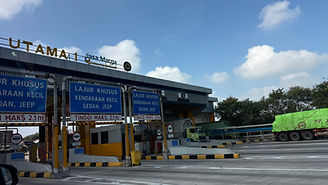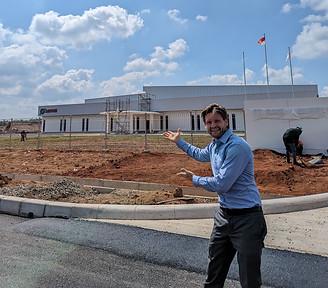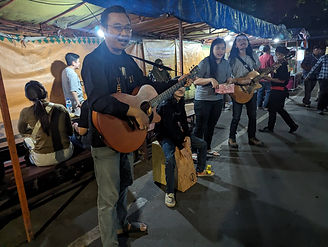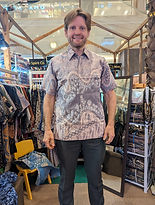

Dirty business in Indonesia: Selling land and gold bars
Burton Flynn and Michael Aguila
July 2024










From dirt to development
When we first set foot on the Subang project site of our Indonesian portfolio company focused on industrial park development in August 2023, it was nothing more than a flat expanse of dirt and weeds. One year later, we returned to see the progress with our own eyes. Operating heavy machinery, teams of engineers and construction workers coordinated to set the groundwork for what will soon become Indonesia’s largest mixed-use industrial hub. The first warehouse is nearing completion, and the surrounding infrastructure projects are progressing rapidly.
As we stood before the nearly completed warehouse, it was clear that this development encapsulated the promise of our investment thesis. The company’s landbank is strategically located near a major seaport, an international airport, and a toll road connecting Jakarta to Central Java, making the site a logistical dream for businesses seeking efficient supply chain management. We believe this competitive advantage will enable the company to continue securing major clients and earning returns on capital north of 20%.

Subang project’s first industrial warehouse which is set to welcome its first client by Q4 2024
The company’s backlog is robust, fueled by demand from sectors like white goods, automakers, and solar PV companies. A key highlight of the Subang project is the world’s largest EV manufacturer from China — even bigger than Tesla — which announced earlier this year that it has bought 108 ha of land to become an anchor tenant and committed to build a $1.3 billion EV plant. Since this announcement, inquiries from China have picked up strongly, further affirming the project’s appeal. During our site visit, we observed representatives conducting soil tests and finalizing plans for this facility, which is expected to begin operations in 2026. The broader ecosystem will include R&D centers, training facilities, and a network of suppliers.

Site of the future manufacturing plant of the world’s largest EV manufacturer
Aside from servicing EV manufacturers, the company also plans to distribute clean energy and will start reporting carbon emissions in its next sustainability report. The firm's ESG efforts are further supported by a certification for its ESG report, which it plans to use to obtain a rating from a third-party ESG agency.
With ample funds for development and a stable gross margin of nearly 30% that should rise substantially with land price increases, the company is well-positioned financially. Potential catalysts that could excite investors include progress on the toll road connecting the industrial park with public infrastructure, as well as ventures into data centers and fiber optics. These initiatives are expected to drive additional investor interest.
Management is extremely upbeat about the prospects, as evidenced by the recent insider transactions: the CEO has personally acquired over $500,000 worth of his company's shares this year, with the majority purchased in the past few months. Additionally, analysts have been consistently upgrading their estimates. With a YTD return of nearly 150%, market sentiment around the stock is very positive, as investors are starting to recognize the value of the company’s strategic initiatives. This momentum could accelerate as the company is expected to report stronger earnings over the next few quarters.

Meeting with the management of a $300m industrial estate developer
Despite this optimism, the valuation remains compelling. The firm is trading at a 65% discount to its net asset value, and its Subang project alone is worth more than the entire company's market cap. Additional growth opportunities in hospitality, construction, and data centers further enhance the upside. According to our estimates, the 2024 P/E ratio is less than 10x, and the 2025 P/E could be below 6x.
For years, the market misunderstood this company’s potential, dismissing it due to choppy earnings. But that’s changing. Investor relations has started educating the market more effectively, and the CEO’s participation in investor conferences and roadshows is helping to share the company’s story. Trading liquidity has improved dramatically, and with the market cap now exceeding $300 million, larger institutional investors are beginning to take notice.




Going for the gold
While Subang showcases industrial development, our visit to a jewelry and gold bar retailer in Jakarta highlighted another dimension of Indonesia’s economic potential. This $150 million company, Indonesia’s only publicly listed gold retailer, is tapping into both tradition and opportunity. Beyond its locally renowned craftsmanship in intricate jewelry, the company’s gold bar exports have quietly become a cornerstone of its revenue — a segment that investors often overlook.
The company’s competitive edge lies in its strong production capacity and trustworthiness, which are critical advantages in a market often clouded by informal players. Its expansion plans include penetrating underdeveloped regions in Indonesia and entering international markets like India, where retail demand for gold is insatiable.
Efforts to modernize production processes, secure London Bullion Market Association accreditation, and participate in Indonesia’s bullion bank project align with positioning the company as a global player. These initiatives, coupled with a clear focus on ESG improvements — including hiring an ESG consultant to refine operations — are part of a broader strategy to build investor trust and ensure long-term sustainability.
Inside one of the company's flagship stores, we observed the duality of its business model: intricate jewelry pieces were displayed alongside gold bars available in "increments ranging from 0.1 grams to 1 kilogram — these small gold bars, often given as baby shower gifts, reflect the company’s ability to merge tradition with modern production practices. Inspired by this, we purchased a 0.1-gram piece as a gift for a 7-year-old son fascinated by “gold nuggets.” This dual focus allows the company to cater to diverse market demands, leveraging its trusted brand in a region dominated by informal competitors.

Buying gifts at one of the company’s many jewelry stores in Jakarta
We believe the business is capable of achieving substantial growth over the next year, driven by rising sales volumes and price increases, which could help drive a stock price re-rating. While risks such as regulatory hurdles and raw material costs remain, potential catalysts include securing new major export partnerships or bringing in a strategic investor. Furthermore, the company’s pawnshop business, which could be worth nearly half its market capitalization, offers a hidden reservoir of value. A subsidiary IPO could unlock significant shareholder returns, in our view.
The broader market is starting to notice, and as the company delivers on its strategy, its value is becoming harder to ignore.

Meeting with the management of a $120m jewelry and gold bar retailer and exporter





Immersing in Indonesia’s Culture
Investing is not just about numbers; it’s also about immersing oneself in the local culture and gaining a deeper understanding of the market and its people. A particularly pleasing aspect of emerging markets investing is the fact that one cannot fully appreciate a country without experiencing its cuisine — and we are always happy to enjoy local delicacies.
After hours spent analyzing balance sheets and touring facilities, we stepped back to experience Jakarta through its flavors and traditions at the iconic Nasi Goreng Kambing Kebon Sirih. Established in 1958, this no-frills food stall with nearly 20,000 Google reviews is famous for its unique goat fried rice — nasi goreng — Indonesia’s national dish.
The atmosphere was bustling and vibrant, with the rich aroma of spices filling the air. Singers performing Indonesian music accompanied by guitar added a charming touch. To top it all off, a performer in an elaborate ondel-ondel Betawi costume added cultural flair to the evening. The Nasi Goreng Kambing was a revelation, with each bite blending tender goat meat and fragrant rice: it was an authentic taste of Jakarta that left a lasting impression.
After dinner, we strolled down a busy road lined with street food vendors, soaking in the lively ambiance of the city. For dessert, we enjoyed traditional Indonesian sweets: soft pandan-flavored kue klepon (a green rice cake) with its burst of sweet palm sugar, and warm, freshly steamed in a bamboo tube kue putu (a cake filled with Javanese sugar). It was the perfect end to our culinary adventure.
As Anthony Bourdain once said, “Food is everything we are. It’s an extension of nationalist feeling, ethnic feeling, your personal history, your province, your region, your tribe, your grandma. It’s inseparable from those from the get-go.”

Tasting the national dish of Indonesia, the Nasi Goreng
We usually wear suits when we meet with CEOs. However, when we travel to Indonesia, we prefer to wear a batik, a traditional shirt integral to Indonesian culture. Batik symbolizes the nation’s rich heritage through its intricate designs and traditional techniques passed down through generations. It is considered formal wear and is worn in various rituals, ceremonies, and celebrations. Most importantly, it is much more comfortable than a business suit in Jakarta’s 40-degree weather!


